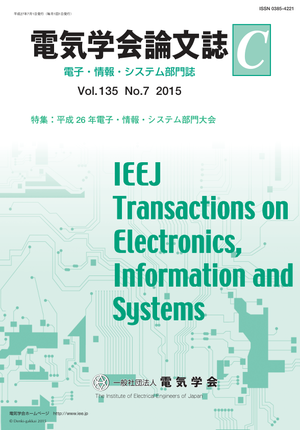Motion-Modulated and Complexity-Modulated Attention Effects on Visual Evoked Potential P300: Applications for P300-Based Brain-Computer Interfaces
Motion-Modulated and Complexity-Modulated Attention Effects on Visual Evoked Potential P300: Applications for P300-Based Brain-Computer Interfaces
カテゴリ: 論文誌(論文単位)
グループ名: 【C】電子・情報・システム部門
発行日: 2015/07/01
タイトル(英語): Motion-Modulated and Complexity-Modulated Attention Effects on Visual Evoked Potential P300: Applications for P300-Based Brain-Computer Interfaces
著者名: Theerawit Wilaiprasitporn (Yagi Labs, Department of Mechanical and Environmental Informatics, Tokyo Institute of Technology), Tohru Yagi (Yagi Labs, Department of Mechanical and Environmental Informatics, Tokyo Institute of Technology)
著者名(英語): Theerawit Wilaiprasitporn (Yagi Labs, Department of Mechanical and Environmental Informatics, Tokyo Institute of Technology), Tohru Yagi (Yagi Labs, Department of Mechanical and Environmental Informatics, Tokyo Institute of Technology)
キーワード: brain-computer interface,visual stimulation,visual attention,P300,EEG
要約(英語): The event-related potential (ERP) P300 is an electroencephalographic correlate of target recognition in decision-making tasks. The P300 is used in several brain-computer interfaces (BCIs) as a non-motor signal of decisions, such as letter choice in the P300-Speller utility. Accuracy in choice specification depends on the difference in P300 amplitude evoked by target versus non-target stimuli. In this study, we describe two novel visual attention stimuli, motion-modulated and complexity-modulated, both of which enhance the difference in P300 magnitude between target and non-target stimuli for P300-based BCIs. In the motion-modulated stimulus condition, subjects were asked to focus on a subtarget randomly appearing between two positions inside the main target. In the complexity-modulated stimulus condition, the spatial frequency of a red-green checkered pattern was modulated (low vs. high). Eight healthy subjects viewed these stimuli while brain signals were recorded by electroencephalography. Under all stimulus conditions, P300 amplitudes were significantly larger in response to targets as measured at a single electrode site (Cz). The high-complexity modulated condition produced the greatest difference in P300 between target and non-target stimuli and significance was reached after only four trials. Stimulus arrays incorporating these stimulus forms may be used for the design of improved P300-based BCIs with greater choice accuracy and speed.
本誌: 電気学会論文誌C(電子・情報・システム部門誌) Vol.135 No.7 (2015) 特集:平成26 年電子・情報・システム部門大会
本誌掲載ページ: 826-831 p
原稿種別: 論文/英語
電子版へのリンク: https://www.jstage.jst.go.jp/article/ieejeiss/135/7/135_826/_article/-char/ja/
受取状況を読み込めませんでした


